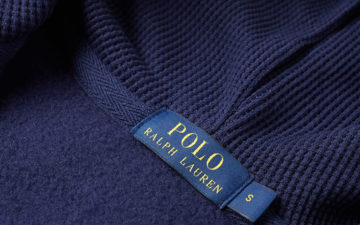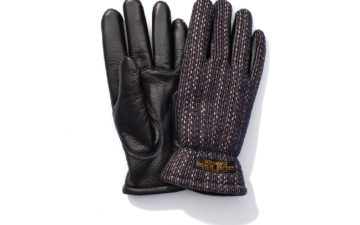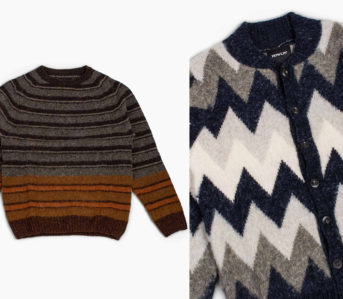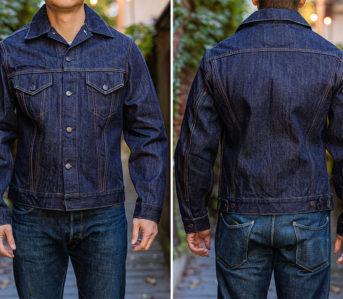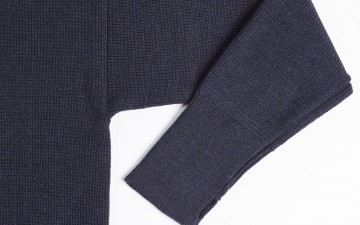Everyone knows the blue-green gemstone, Turquoise. Its distinct color can be identified from a mile away. You’ve seen it inlaid in rings, pendants, bolo ties, squash blossom necklaces, conchos, studs, and more. So much of it dots the hands and necks of those deep into southwestern Americana aesthetics, but the story isn’t limited to our little corner of the world, despite the fact that this beautifully teal-hued gemstone often seems to go hand-in-hand with vintage and heritage-inspired fashion.
So, why do we see turquoise so often in our niche? How long have humans been mining for, trading, and appreciating this whimsical stone? We’ll look to answer those questions and look at the history of turquoise in this article.
What is Turquoise?
Turquoise is a precious gemstone primarily found in Cambrian-era Quartzite rocks and quartz-laden granite rock located in the United States, Iran, and the Sinai Peninsula in Egypt. It’s been traded for thousands of years, with artisans located around the world working the stone into wearable art, sculpture, and trinkets. Even King Tut’s burial mask is inlaid with the stuff.
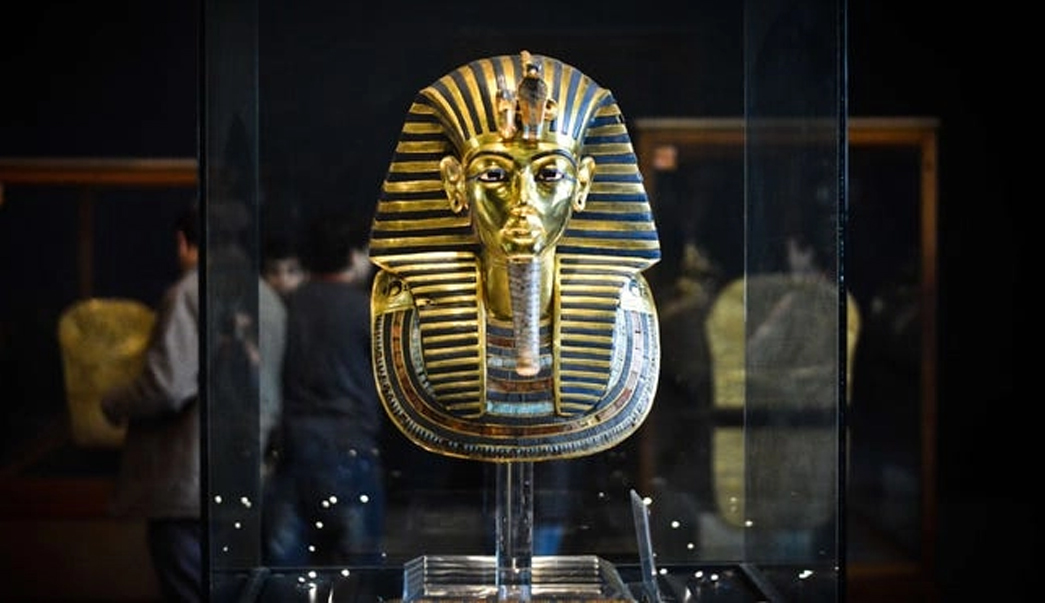
King Tut’s Mask, Image via USA Today
Turquoise is a soft copper-aluminum phosphate mineral. It forms when meteoric water from rain or snowmelt combines and interacts with copper minerals in the earth. Its bright color and rare occurrence made it both desirable and valuable. Turquoise has a spectrum of vividness in color and hardness, richer blue and green tones are often more desirable and valuable, as well as harder and more durable stones.
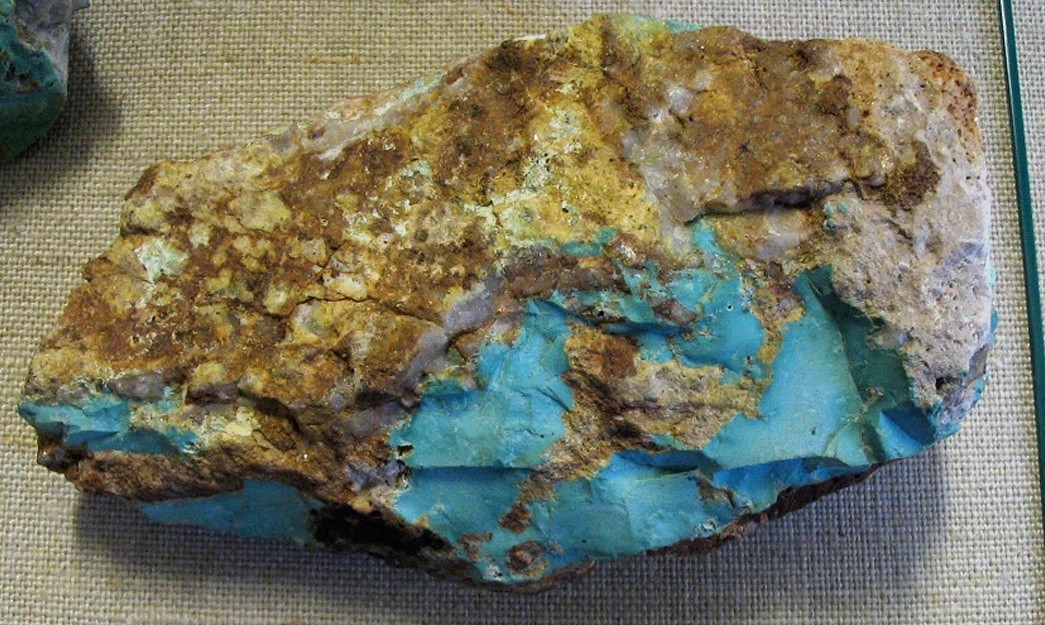
Image via Wikipedia
The stone’s generally soft quality makes it easy to cut and use in many different applications, with jewelry being a major one, as small pieces are easily formed into beads and inlay. Its softness also means it’s fragile and prone to damage and alteration, therefore it must be properly cared for. Things to keep in mind when caring for turquoise are:
- Certain chemicals and solutions can affect the composition and appearance of the stone. Avoid products that contain hydrochloric acid, like harsher chemical cleaning products
- Storing the stone among other jewelry or objects that can chip or scratch the surface of the stone is not advised.
- Turquoise can be washed with warm, natural soapy water, but should be kept away from steam.
Different Types and Qualities of Turquoise

image via Geology
While the whimsical light/sky-bluey green is often the tone that comes to mind when you think of the word turquoise, the stone can actually be any color between emerald green and sky blue, and everything in between. the above image shows just some of the tones of turquoise that can appear.
Measuring the quality of a piece of turquoise is a broad subject and it is one of the few precious stones that doesn’t have a dedicated grading system. . The quality of turquoise is also measured by assessing the color and texture of the stone, as well the absence or presence of traces of its host rock. Known as the ‘matrix’, these remnants of host rock are seen in form of veins, splotches, or other shapes. While these indicate a generally “lower-quality” stone, they actually look fantastic and produce a gorgeous, one-of-a-kind pattern, unique to each and every stone. This is probably why you see veiny, textured stones used by Japanese designers who appreciate the wabi-sabi imperfections of these kinds of stones. Generally speaking, the most valuable turquoise is a hard, solid piece of vivid mid-to-sky blue stone — which is often called “robin’s egg blue” — with no matrix.
But there are also different treatments applied to turquoise to take it from its delicate, natural form, to a consumer-ready product that can be worn or used to decorate something. Two common treatments are:
- Fats or waxes – Turquoise is often treated with fats, oils, or waxes to coat the stone and stop foreign bodies from entering its pores, thus protecting it. This also adds a lustrous sheen to the stone. This is a temporary treatment that may need re-applying at some point in the life of the stone.
- Stabilization – Soft, lower-quality turquoise is often ‘stabilized’ to improve its hardness and overall appearance. The stabilization process puts the stone under high pressure, causing it to absorb either epoxy resin or plastic into its pores. This makes the stone harder, less porous, and more suitable for like jewelry.
The cheapest and least recommended form of turquoise is ‘reconstituted’ turquoise. This is produced by taking lots of fragments of low-quality turquoise, grinding them into a powder, and binding the resulting powder with epoxy to create one large piece of reconstituted turquoise.
A Brief History of Turquoise
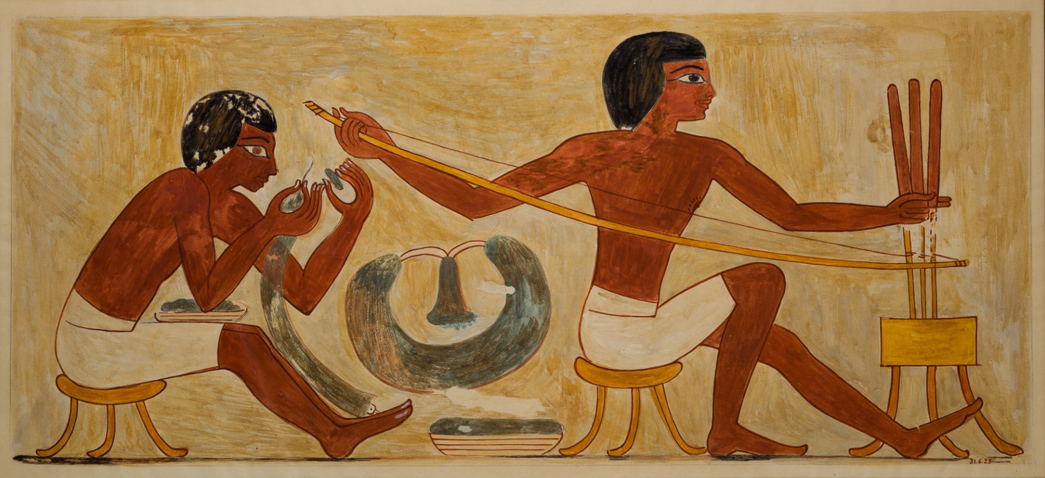
Image via The Met
Turquoise was one of the first gemstones in history to be mined, with most historical sites in the once capital of turquoise mining, Central Asia, now depleted, but one located in the United States is still in operation. The stone was first brought to the west by the Ottoman Empire in the 13th century, and the French coining of the stone, pierre tourques (“Turkish Stone”) was adopted as its name because of trade routes leading to the west through Turkey.
The oldest turquoise mines trace back to Egypt, and the earliest recorded uses of turquoise were by Egyptians, with uses of the stone being highly varied. Its decorative nature and protective qualities meant turquoise made its way onto amulets, beads, inlay in gold jewelry, stone sculptures, and tomb decorations (like King Tut’s tomb). Egyptians called the stone mekfat, meaning ‘joy’ and ‘delight’. Turquoise’s bright blue and green hues became popular in Egyptian color schemes, and its rarity meant that the precious stone was greatly valued, thus it became associated with wealth and royalty
The Aztecs traded turquoise with indigenous Americans and used it in ceremonial masks, weapons, armor, and jewelry, as a symbol of fire and a sign of distinction. The stone was inlaid in gold, coral, and other materials in various ways including mosaic applications.
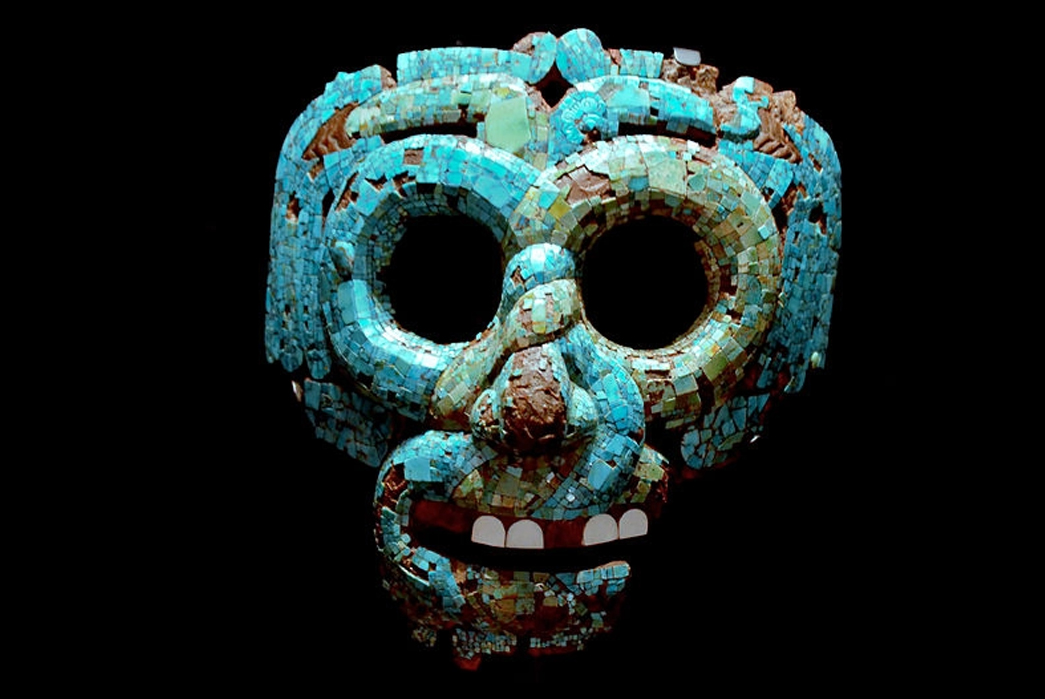
An Aztec Quetzalcoatl Mask, Image via Wikimedia
In Iran, turquoise has been mined for thousands of years. It’s been used as decoration in jewelry, turbans, weapons, armor, and was often etched with Arabic script. The Persian word for turquoise is pirouzeh, meaning “victory”, and the stone’s vibrancy portended a win or loss in times of war Pure Persian turquoise is known for its smooth texture and aforementioned “robin’s egg blue” color, and set the standard for the highest quality, with less desirable texture and color stones being devalued in comparison.
Other, less significant sources of Turquoise include parts of Eastern Europe, China, Tibet, Afghanistan, Australia, India, Chile, and more.
Turquoise may have been one of the oldest mined stones in recorded history, but it wasn’t until the decline of Roman Catholic Church influence in the 14th century that its importance and use in jewelry in the West began, and the stone made its way to the rest of the world. In addition to being adored for its beautiful blue hues, it was commonly believed during this time by many cultures that turquoise would ward off ill health and imbue its wearer with certain protections.
The demand for turquoise around the world eventually created a market for synthetic, or imitation turquoise. Glass, plastic, clay, and more highly occurring stones were transformed with cutting, tumbling, and dying into products to recreate the look and feel of the stone. A gemologist or jeweler can perform tests on imitation gemstones to confirm their synthetic or imitative properties.
Turquoise in Native America
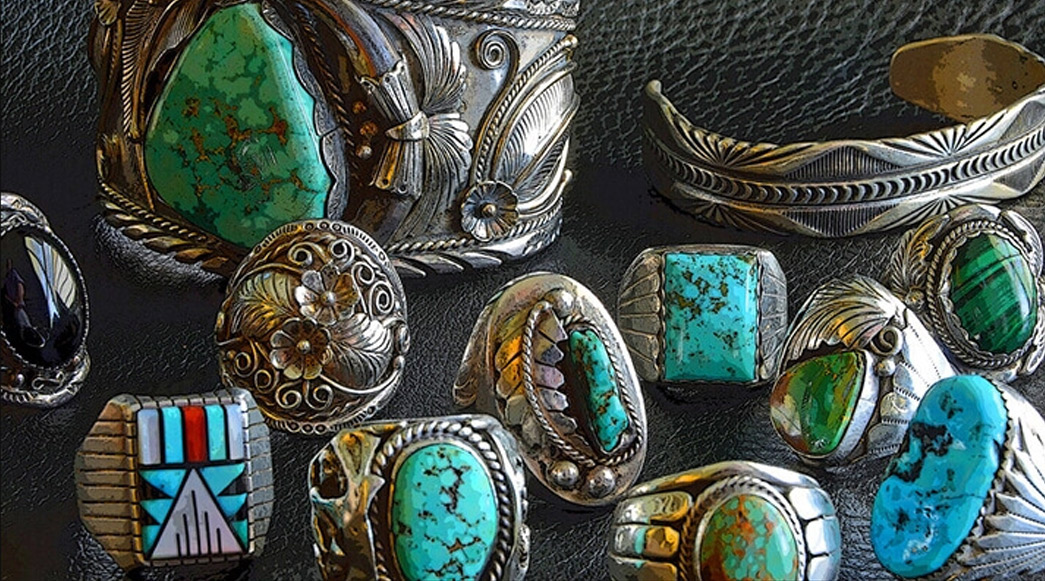
Image via Southwest Silver Gallery
With so much turquoise naturally occurring in the region now known as the United States, many native indigenous tribes used (and still use) the stone in various applications, with jewelry being the best-known use. Native motifs and imagery have always had a place in American fashion, with patterned fabrics being utilized in many garments, feather designs in jewelry, ornate vintage and reproduction squash blossom necklaces, stone-inlaid rings, and more.
Modern-day states that have contained turquoise include California, Arizona, Nevada, and Colorado, but New Mexico is the oldest known source of USA-based turquoise mining. Only one mine in California (Apache Canyon) is in commercial operation today. Most American turquoise is considered to be a lower grade (especially when compared to its Persian counterparts) and is known as “chalk turquoise”. Turquoise in America is mostly found as smaller-sized veins or seam fillings between other rocks.
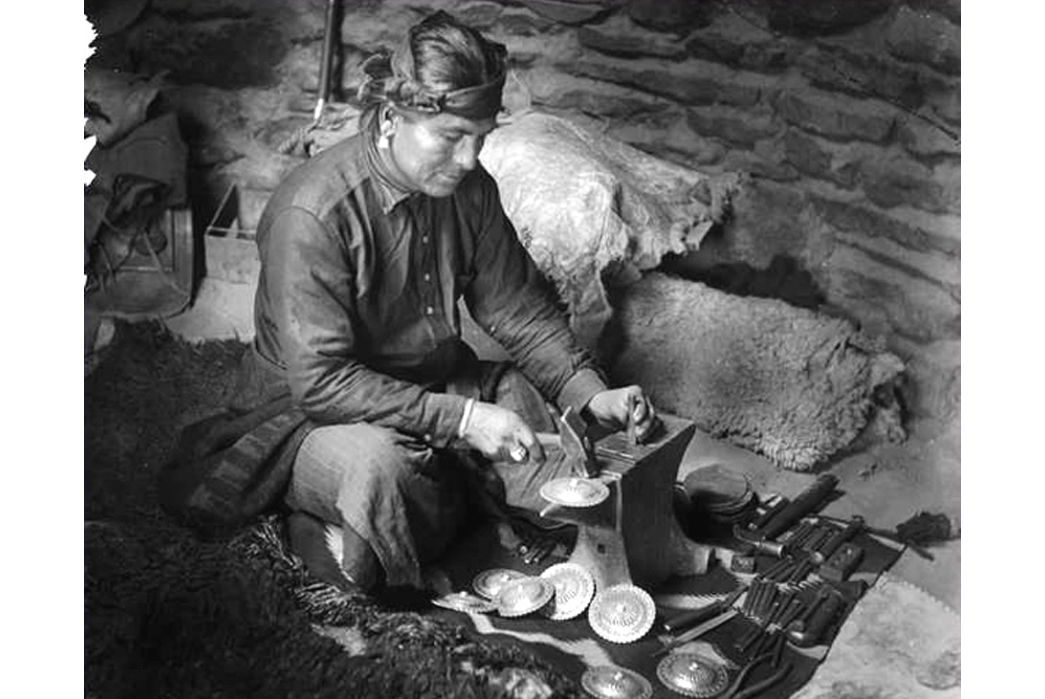
Image via Crow Canyon
Indigenous tribes such as the Apache, Hopi, Navajo, Zuni, and many more, have turned precious gems, stones, shells, and feathers into jewelry for thousands of years. Each tribe’s designs, motifs, and utilizations are distinct, but there are some commonalities. A lot of emphasis is put on the symbolic and spiritual nature of materials. Prior to colonization, indigenous people carved profoundly meaningful turquoise out of rock manually with stone tools.
Like the world’s various cultures, indigenous tribes have many beliefs and uses for turquoise. The Apache believed that turquoise inlaid in a bow (and even guns) would improve their accuracy and skills as warriors, and associated its blue with rain at the end of a rainbow. Hopi miners carried the stone to give them strength and security in their daily pursuits. The Navajo associated the stone with the blue of the sky and water and keeping in tune with the elements. They even used a “turquoise stick” in aid of finding water. The Zuni used turquoise in amulets and jewelry depicting idyllic figures. The Ojibwe Dream Catcher often contains a turquoise “Spider” bead that symbolizes Asibikaashi, a spider woman who returned the Ojibwe’s missing sun, with the Dream Catcher protecting Ojibwe children from dark dreams/nightmares.
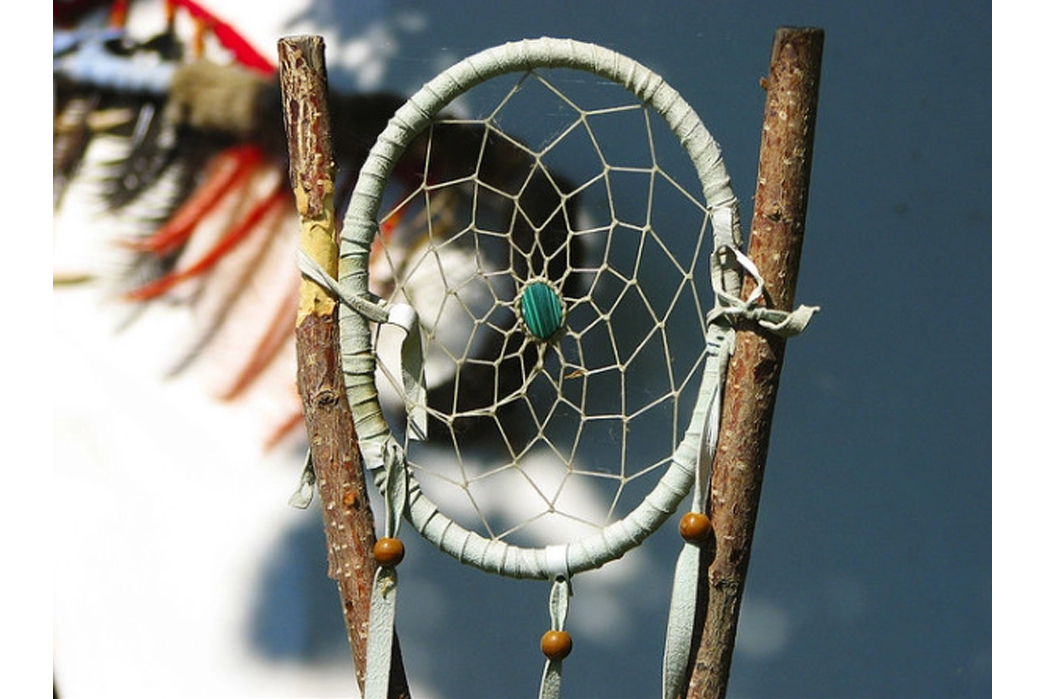
Image via Dream-Catchers
The Navajo are among the best-known turquoise jewelers in the world, with the original silversmith Navajo jeweler Atsidi Sani learning to work with metals from Mexicans in the 1850s. Many of Sani’s ideas and motifs still exist to this day, eternally beautiful squash blossom necklaces and turquoise-inlaid rings were born out of Sani’s work and teachings.
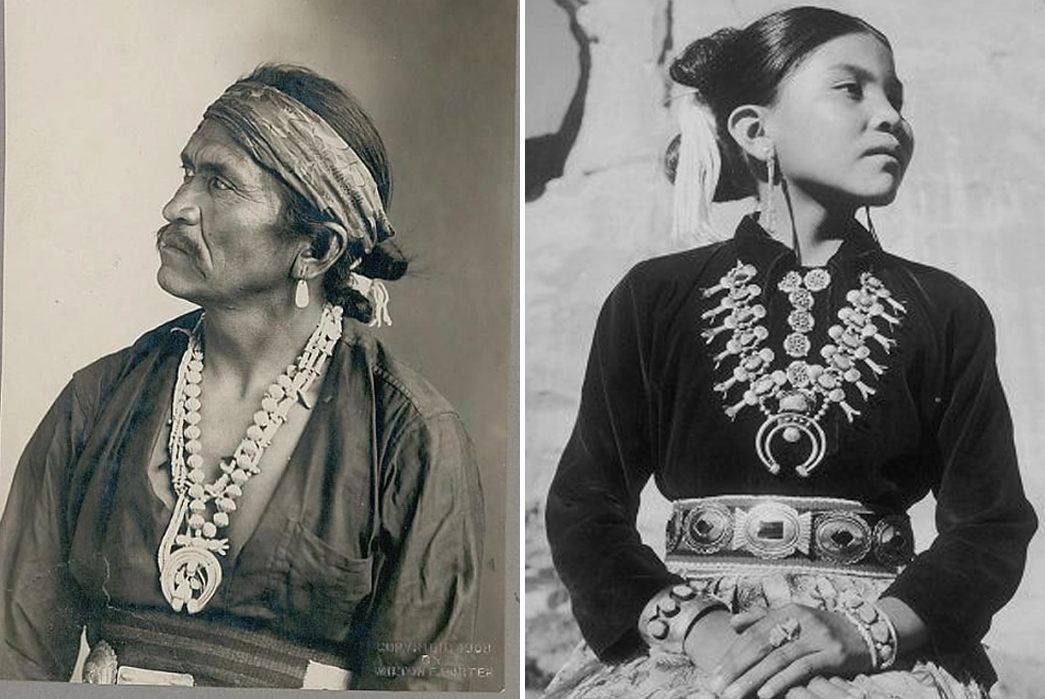
Image via Navajo People and Image via Cashmere and Camo
Turquoise Today
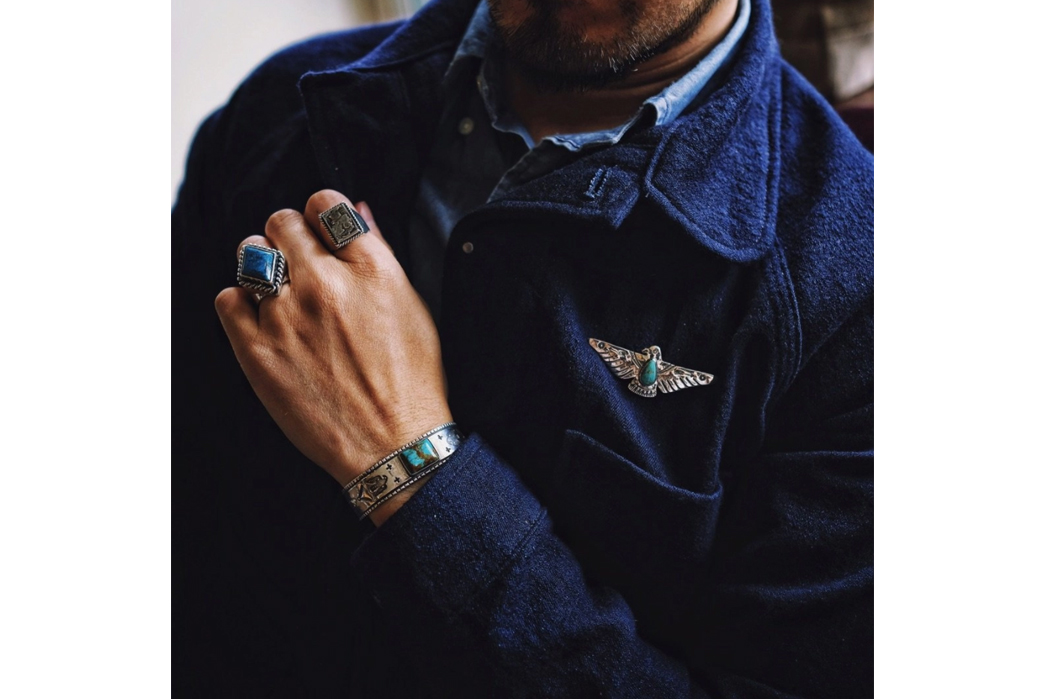
Image via Pinterest
Today, while not as naturally occurring as it once was, turquoise is plentiful. With all shapes and sizes of turquoise available to utilize in many different fashions. The occurrence of synthetic turquoise has devalued the stone some, so it’s generally affordable, depending on its sourcing and application. The bright and beautiful blue stone remains desirable for its bold natural coloring as it was in the past when the stone was less common.
Modern Egyptian, Iranian, and Indigenous American artisans now source their gemstones from all over, but the United States is where it’s most plentiful, with the only operational commercial turquoise mine left in the world.
Products
The main way that the heritage scene interacts with turquoise is through jewelry inspired by Native American designs, and sadly, no authentic indigenous makers have managed to make a name for themselves within a scene that appreciates their designs so dearly. This means it is incredibly important that if you are thinking about investing in some turquoise-imbued jewelry, do your research and ensure that you are aware of the potentially indigenous and sacred roots of your purchase. With that, here are some products from indigenous makers,
Mike Bird-Romero, San Juan Silver Bracelet with Two Turquoise Cabochons

Mike Bird-Romero is a Native jeweler born in 1946. From a family of potters and textile artists, Bird-Romero taught himself metalwork to become a prominent designer of contemporary Native American-inspired jewelry.
This cuff is a great example of Bird-Romero’s stellar work, which is typically a robust piece of chunky sterling silver, adorned with precious stones, ornate forms, and charming carvings. The choice of a veiny, matrix-ridden turquoise stone on this cuff provides some textured contrast to the smooth silver.
Available from Shiprock Santa Fe for $900
Fritson Toledo Turquoise Cuff
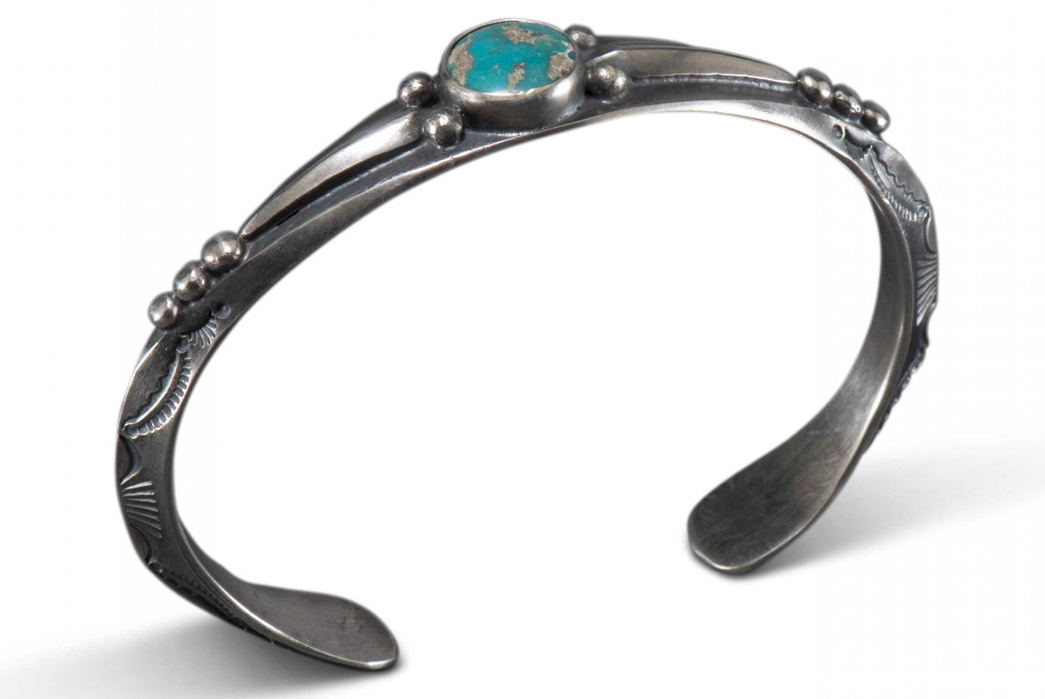
Born in New Mexico in 1961, Fritson Toledo is a Navajo artisan who has been working as a silversmith since his teens. Toledo produces a range of jewelry, largely inspired by his native heritage and the natural world around him. Crafted from sterling silver, this cuff features gorgeous carved details and is inlaid with a piece of natural turquoise.
Available for $310 from Four Winds Gallery
Horace Iule, Zuni Silver Cross Pendant with Seven Turquoise Cabochons on Handmade Chain, c.1960

Born in 1901, Horace Iule was a Zuni silversmith known for his mastery of silver casting. Iule began working as a silversmith in the 1930s after returning from school in Phoenix where he had studied blacksmithing. He was one of the first Zunis to create the Knifewing god in silver
This is an original Iule piece available at Shiprock Santa Fe, a native-owned gallery who have consulted legendary Japanese streetwear Visvim, for $1200
Turquoise and Silver in Japan
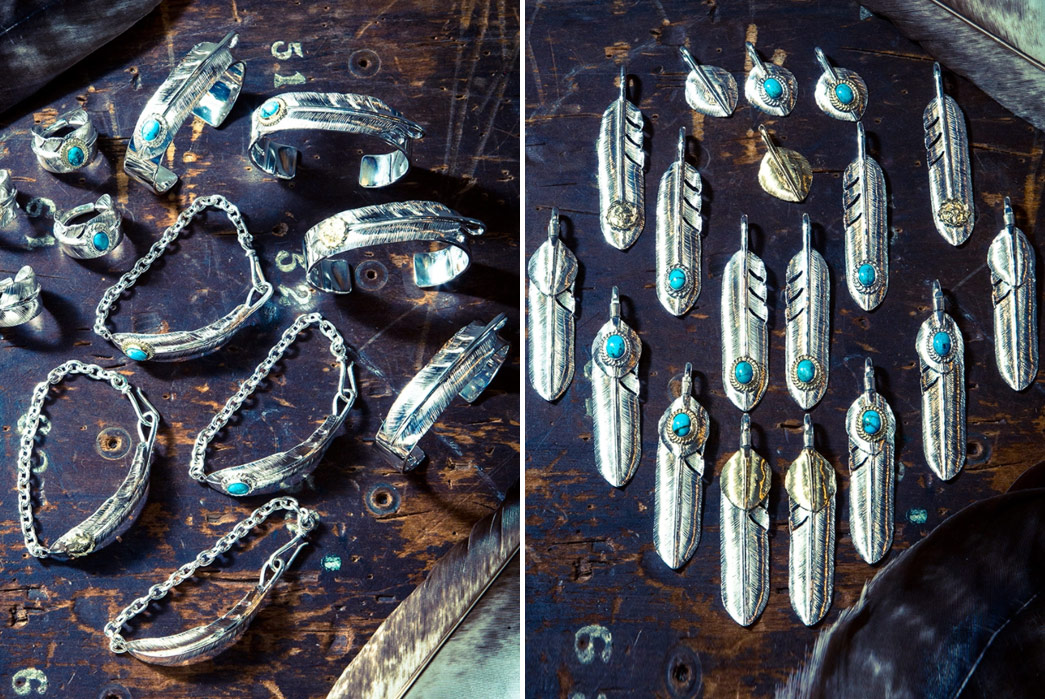
Image via First Arrows
Japanese silversmiths have taken to reproducing indigenous American art and jewelry in order to honor and continue tribal traditions. With Japan being a craft-based country, a great deal of focus and commitment has been put into harnessing traditional techniques, while respecting indigenous ideas and motifs. Designers like Goros Takeshi have spent valuable time among indigenous tribes in order to learn and continue the craft.
Here are some examples of Japanese silver goods that make use of turquoise in their goods.
First Arrows 8mm Silver Bangle with Turquoise
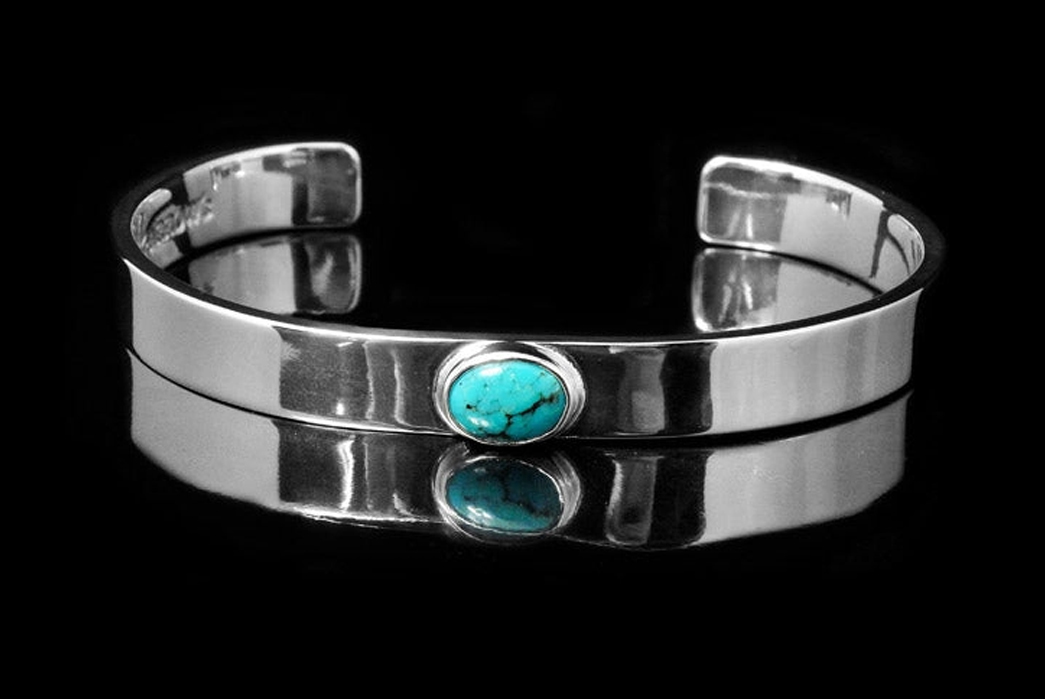
Image via Corlection
The Japanese devotion to Americana culture and fashion doesn’t stop at denim, First Arrow’s is making Indigenous-American-style jewelry, with the same traditional Indigenous motifs and techniques that have existed for over a century. Founded by Japanese silversmith Kazuya Ito, First Arrow’s expertly crafted designs can’t be ignored when talking about modern indigenous-style jewelry reproductions.
The bangle is composed of 95-5 950 Silver and “classified metal”, the latter of which is kept a secret as the brand believes it leads to a unique patina. This simple 8mm wide bangle design features a nicely textured piece of turquoise inlaid in the center, with a First Arrow’s stamp and logo on the interior.
Available for $265 from Corlection.
Munqa Pin Badge with Turquoise Jaws
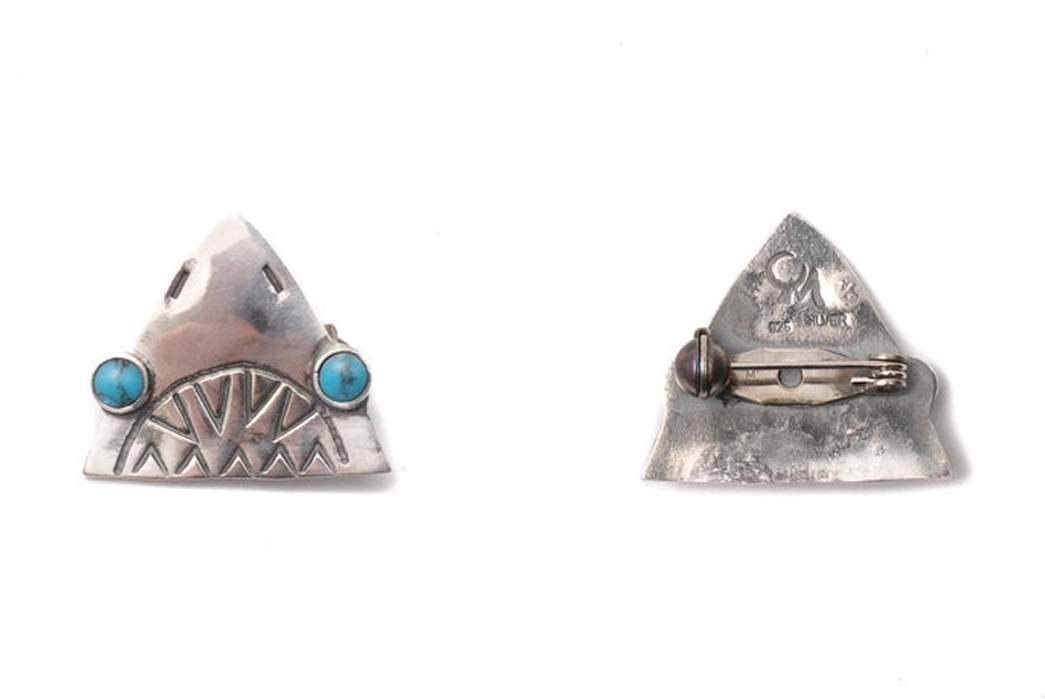
Munqa of Japan likes to show a more playful side when producing their silver jewelry, case in point, the Pin Badge with Turquoise Jaws. This fun wearable pin badge design features an ominous shark silhouette with turquoise stones as eyes. There’s nothing scary about that, it’s refreshing to see high-craft silversmithing not take itself too seriously.
The Pin Badge is made in Japan from .925 sterling silver, with nice bright blue and spotty turquoise stones inlaid as eyes, and is detailed with a nice and secure metal pin back.
Available for $110 at Clutch Cafe.
Legend “Anti-Ghost” Ring with Turquoise
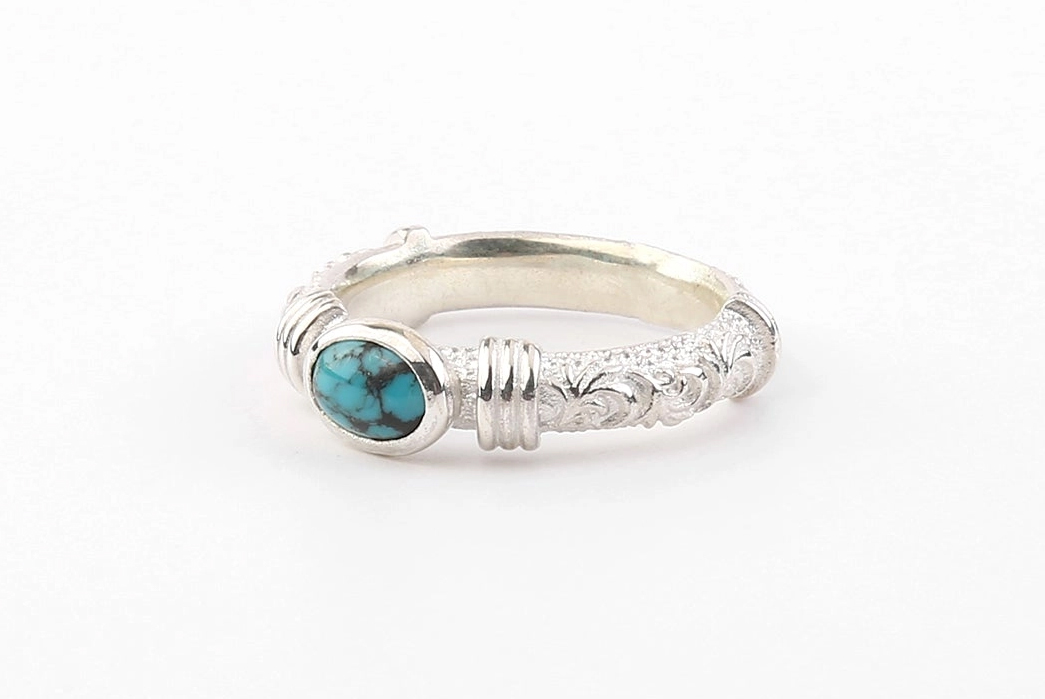
Image via Corlection
Japanese silver brand Legend‘s “Anti-Ghost” Ring with Turquoise is a seriously nice piece of jewelry to incorporate a bit of ornate turquoise into your ring rotation (ringtation). The design is anti-bad vibes, according to the brand’s proprietor, Nao. This deceivingly simple ring is subtly channeling indigenous design with its own modern spin. Zoom in on the texture of the band, it’s simply something else. Legendary, one could say.
Featuring a 6.5mm wide band, the ring is composed of 92.5% silver and 7.5% classified metal, making for a 100% beautiful future heirloom.
Available for $213 from Corlection.
An Important Final Word
The reason turquoise is relevant to our niche is solely down to the reproduction of Native American jewelry designs. Jewelry sourced from American tribes, depicting American tribal imagery, motifs, and ideals, should be treated with the appropriate respect. Directly supporting native designers is of utmost importance when sourcing new jewelry, as the profound nature of each specific design can more easily be understood when being acquired by their maker, reducing the harm toward indigenous people’s beliefs, identities, and cultures.
If you can’t find a design you like from a Native maker, consider requesting a custom from one, or consider donating to a charity that supports our Native population like NAHA if you do end up purchasing a reproduction design from a brand like First Arrow’s or Legend.

